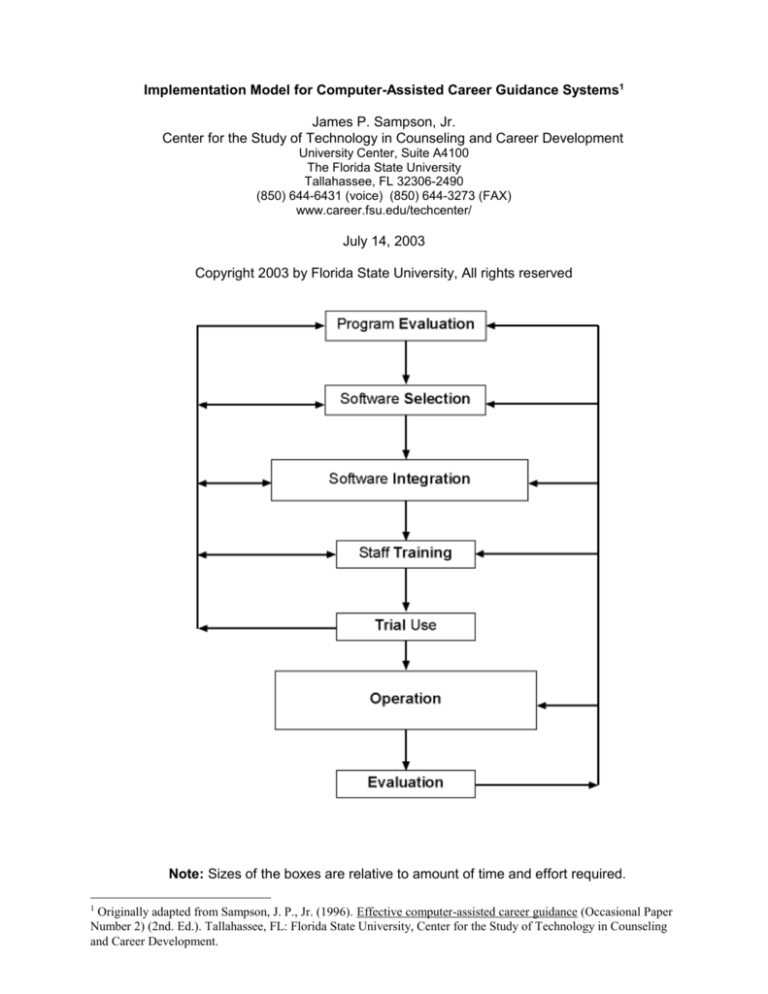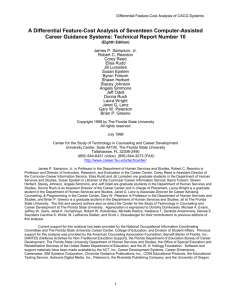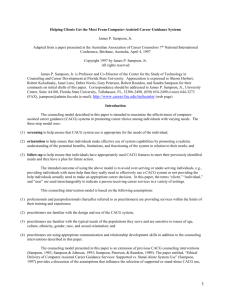
Implementation Model for Computer-Assisted Career Guidance Systems1
James P. Sampson, Jr.
Center for the Study of Technology in Counseling and Career Development
University Center, Suite A4100
The Florida State University
Tallahassee, FL 32306-2490
(850) 644-6431 (voice) (850) 644-3273 (FAX)
www.career.fsu.edu/techcenter/
July 14, 2003
Copyright 2003 by Florida State University, All rights reserved
Note: Sizes of the boxes are relative to amount of time and effort required.
1
Originally adapted from Sampson, J. P., Jr. (1996). Effective computer-assisted career guidance (Occasional Paper
Number 2) (2nd. Ed.). Tallahassee, FL: Florida State University, Center for the Study of Technology in Counseling
and Career Development.
Implementation Model for CACG Systems 2
Implementation Model for Computer-Assisted Career Guidance (CACG) Systems
Program evaluation. This step provides the foundation for the implementation process,
helping to ensure that the CACG system is used for the right reasons with the right clients. The
process begins with an evaluation of how well the resources and services of the organization are
currently meeting client needs. If the evaluation indicates that a change in service delivery is
necessary, then the features of typical CACG systems are reviewed. If a new CACG system seems
appropriate, the organization then prepares for the implementation process by establishing an
implementation committee and a coordinator to guide the process. An implementation plan is
prepared and support is sought from stakeholders and administrators for the use of the system. As
shown in Figure 1, the program evaluation process ideally occurs within the context of strategic
planning. This helps to ensure that the scope of program evaluation is congruent with the strategic
issues that affect the organization.
Software selection. Using the above program evaluation data, this step helps to ensure that
the CACG software selected has the potential to effectively meet client needs. The process begins
with the implementation committee identifying CACG systems that have the assessment, information,
and learning features that might meet identified client needs. After evaluating the features, quality,
and costs of the systems, the most appropriate software is selected.
Software integration. Given the software selected in the previous step, staff now plan how
to integrate CACG system use in a way that is congruent with the way in which services are delivered
within the organization. The process begins with the staff reviewing current needs and current
resources and services. After the CACG system is installed, staff become familiar with the software
and then evaluating how the system "fits" with existing and/or new services. A plan is then developed
for connecting the CACG system with other organizational resources and services. The roles for all
staff members are determined, including specific professional, paraprofessional, and clerical support
staff interventions with clients. Operational procedures are determined and a plan for evaluating
CACG system use is prepared. Public relations efforts also continue.
Staff training. Staff are now given the training necessary to integrate the CACG system with
existing service delivery. The process begins with developing a plan for training. Professionals,
paraprofessionals, and clerical support staff then receive specific training that is appropriate for their
role in delivering services. Administrators and stakeholders are then familiarized with CACG system
features and use. The effectiveness of training is then evaluated with plans made for future training
activities.
Trial use. The effectiveness of CACG service delivery, based on the software integration and
staff training efforts completed above, is evaluated with a group of trial users. The process begins with
an identification of trial users followed by their trial use of the system. Based on observations and
interviews of trial users, staff roles, operational procedures, and training efforts are modified as
needed.
Operation. Building upon the experience gained in the trial period, the CACG system is used
as one component of the total service delivery effort of the organization. Evaluation data is collected
and public relations efforts continue.
Evaluation. Building upon the experience gained during operation, results of the evaluation
are used to indicate needed improvements in CACG service delivery. Information gained in this step
is then used in the refinement of CACG service delivery. Depending on the nature of the evaluation
results obtained and the resulting changes that are needed, the implementation process cycles back
via feedback loops to program evaluation, software selection, software integration, or staff training,
followed by trial use and continuing operation of the CACG system.
Implementation Model for CACG Systems 3
Implementation Model for Computer-Assisted Career Guidance (CACG) Systems
Program Evaluation
Evaluate Currently Available Resources and Services
Review the Career Decision-Making Needs of Clients
Review the Features of Currently Available Assessment, Information, and Learning Resources
Review the Services Provided to Help Clients Effectively Use Available Resources
Identify Client Needs that are Met Effectively with Currently Available Resources and Services
Identify Gaps in Current Resources and Services in Effectively Meeting Client Needs
Briefly Review the Features of Typical CACG Systems
Decide if a CACG System Can Narrow Gaps in Resources and Services
Prepare for Implementing a CACG System
Create a CACG Implementation Committee and Choose a System Site Coordinator
Prepare a Plan for Implementing a CACG System
Identify Stakeholders and Administrators Who Can Provide Support for Improved Services
Software Selection
Identify CACG Systems That Have Assessment, Information, and Learning Features That Might Meet
Clients' Needs
Evaluate the Features, Quality, and Costs of the CACG Systems Being Considered
Select the CACG System That Best Balances Features, Quality, and Costs
Software Integration
Prepare for Integrating A CACG System With Existing or New Services
Review the Needs of Clients, Staff, the Career Service, and the Institution
Review Current Services Provided to Help Clients Use Assessment, Information, and Learning
Resources
Discuss Theory and Practice Issues Among Staff to Generate Ideas About Existing or New
Services to Help Clients Use a CACG System
Review Professional Standards on the Use of CACG Systems to Generate Ideas About the Quality
of Services Provided to Clients
Install the System
Choose Available Computer Hardware to Run the System or Install New Hardware for the System
Install the Software
Familiarize Staff with CACG System Features and Operation
Decide How the CACG System Will be Used in Delivering Services
Decide How the System Can be Used With Other Assessment, Information, and Learning
Resources
Decide How Counselors, Paraprofessionals, and Clerical Support Staff Can Help Clients Make
Effective Use of the System
Decide How the System Might be Used Collaboratively With Other Service Providers in the
Institution
Decide How the CACG System Will Operate
Decide How Counselors, Paraprofessionals, and Clerical Support Staff Will be Supervised
Decide on the Number of Computer Work Stations Needed to Meet Demand for the System
Decide on the Physical Location of Computer Work Stations for the System
Develop Procedures for Scheduling Client Use of the System
Develop a Plan for Evaluating CACG System Effectiveness
Revise Public Relations Efforts to Include the System
Communicate Progress with Stakeholders and Administrators Who Can Provide Support
Staff Training
Decide if Outside Assistance is Needed with CACG System Training
Develop a Plan for Staff Training
Implementation Model for CACG Systems 4
Train Professionals, Paraprofessionals, and Clerical Support Staff
Familiarize Administrators and Stakeholders With CACG System Features and Use
Evaluate Training Effectiveness and Plan Future Training
Continue Staff Training as Needed
Trial Use
Identify Trial Users
Begin Trial Use of the System
Observe and Interview Trial Users to Identify the Strengths and Limitations of Resources and
Services that Support CACG System Use
Revise Staff Roles and Operational Procedures as Needed
Continue Staff Training as Needed
Continue Public Relations Efforts
Operation
Operate the System
Collect Evaluation Data
Continue Public Relations Efforts
Evaluation
Evaluate the Use of the CACG System as a Service Delivery Resource
Refine Resources and Services that Support CACG System Use Based on Evaluation Results
Reference
Sampson, J. P., Jr. (1996). Effective computer-assisted career guidance (Occasional Paper
Number 2) (2nd. Ed.). Tallahassee, FL: Florida State University, Center for the Study of Technology
in Counseling and Career Development.









